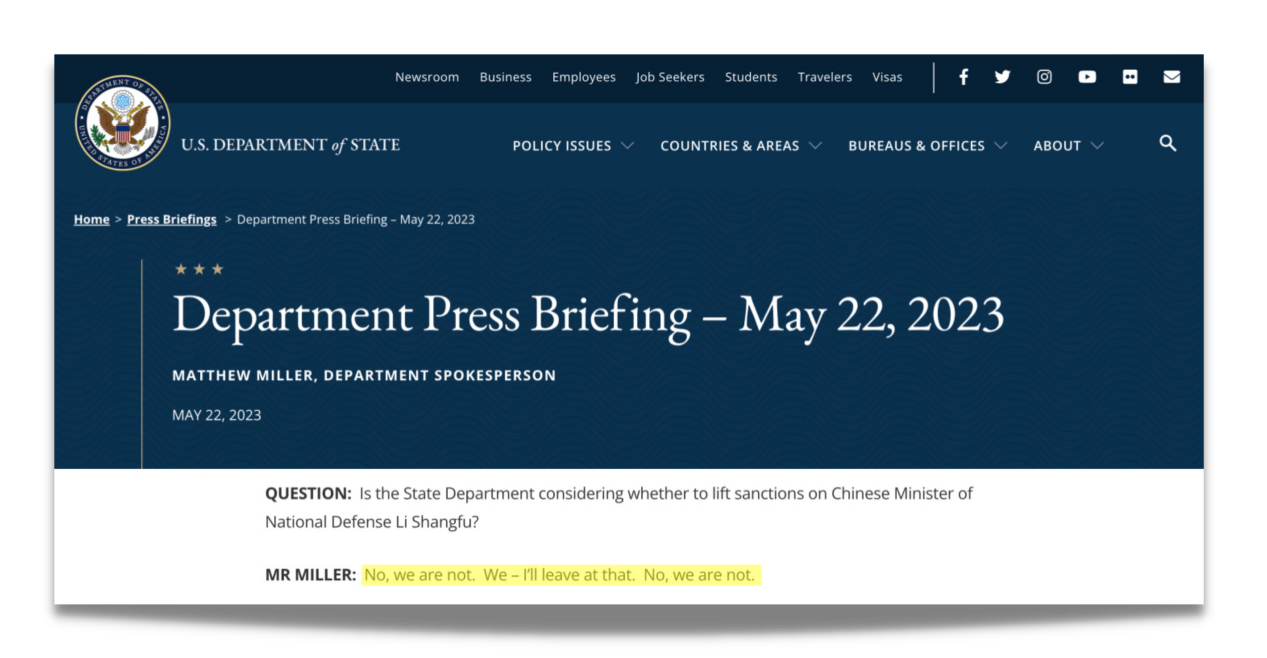Recently, the 20th Shangri-La Dialogue concluded in Singapore. During the Dialogue, US Secretary of Defense Lloyd Austin stated, “I am deeply concerned that the PRC (People’s Republic of China) has been unwilling to engage more seriously on better mechanisms for crisis management between our two militaries.”
Prior to this Dialogue, the US side had released multiple messages claiming that the Chinese Defense Ministry refused the request for a meeting between the Chinese and US defense ministers during the Dialogue, stating that they had made weeks of efforts to ensure this meeting.
In response to this, Lieutenant General Jing Jianfeng, deputy chief of the Joint Staff Department of China’s Central Military Commission, stressed at a media briefing that China attaches importance to the China-US military relationship, and that contact between the two sides has never stopped. The US side has not created conditions for the formal meeting at the Shangri-La Dialogue between the two defense ministers.
Does the US side truly show sincerity in requesting a meeting between the Chinese and US defense ministers? Apart from verbal statements, what preparation has the US done for the meeting?
The US demands the meeting but refuses to lift sanctions on the Chinese defense minister
The US claims to be prepared for a meeting with the Chinese military, but the Chinese State Councilor and Defense Minister General Li Shangfu, whom Austin is eager to talk with, is still on the US sanctions list.
In 2018, Li Shangfu, then Minister of the Equipment Development Department of China’s Central Military Commission, approved the purchase of Su-35 fighter jets and S-400 air defense missiles from Russia, implementing a normal arms procurement plan.
However, the US government believed that this action violated the US domestic law known as the “Countering America’s Adversaries Through Sanctions Act” and imposed sanctions on Li Shangfu. This was the first time the US sanctioned a senior Chinese military officer.
At that time, the Chinese Ministry of Foreign Affairs expressed “strong indignation” against the US actions and urged the US to immediately correct its mistake and lift the so-called sanctions. However, as of the day of the Shangri-La Dialogue, the US has still done nothing.
During a press briefing at the US Department of State on May 22 this year, a reporter asked, “Is the State Department considering lifting sanctions on Chinese Minister of National Defense Li Shangfu?” State Department spokesperson Miller said, “No, we are not. We-I’ll leave at that. No, we are not.”

Record of the US Department of State’s press briefing-May 22
While the US complained that they cannot have a meeting between the Chinese and US defense ministers, they refuse to lift sanctions on the Chinese defense minister. How sincere is the US in engaging in the meeting with China?
The US seeks reconciliation between the two sides but repeatedly takes risks intentionally
On June 3, the US destroyer USS Chung-Hoon and the Royal Canadian Navy frigate HMCS Montreal passed through the Taiwan Strait and publicly stirred up the situation.
Later that day, a journalist from Canada’s Global News, who was on board, revealed an incident in which the Chinese People’s Liberation Army warship warned against the provocative actions of the US and Canada.
Just last week, the US military also claimed that a Chinese fighter jet conducted an “unnecessarily aggressive manoeuvre” against it in the so-called “international airspace” of the South China Sea.
In response to this, Chinese Defense Minister Li Shangfu stated during the Shangri-La Dialogue, saying, “Why did the questions you just asked all happen in or near Chinese airspace and waters, rather than in or near the airspace and waters of other countries? This is because Chinese military aircraft and warships never go near the airspace and waters of other countries to conduct so-called ‘hegemonic manoeuvres’.”
In addition to threatening China’s sovereignty under the name of maintaining “freedom of navigation,” the US has also sold weapons to Taiwan multiple times in the past six months, repeatedly violating relevant provisions of the three joint communiqués between China and the US.
In December last year and March this year, the US State Department approved the sale of four weapons systems worth over 1.2 billion USD to Taiwan. And according to Taiwan’s defense authorities, the US government provided Taiwan with weapons systems worth 500 million USD last month.
The US side emphasizes maintaining stability in the Taiwan Strait and opposes unilateral changes in the status quo, but at the same time, it continues to accelerate arms sales to Taiwan and intensify tensions in the Taiwan Strait. The inconsistent words and actions of the US side, and the lack of sincerity, have repeatedly narrowed the space for a bilateral meeting.
In November of last year, shortly after the meeting between the Chinese and US presidents at the APEC summit in Bali, the Chinese and US defense ministers held talks in Cambodia, and both sides agreed that the two militaries should earnestly implement the important consensus reached by the two heads of state, maintain communication and contact, strengthen crisis management and control, and strive to maintain regional security and stability.
However, the recent series of actions by the US side has not given people a sense of true sincerity and lacks the concrete actions needed to facilitate a meeting between the Chinese and US military.
Lieutenant General Jing Jianfeng gave three statements to the US side during the Dialogue: “Leadership is not hegemony, position depends on performance, and actions speak louder than words.”
All in all, whether the Chinese and US military can have a meeting still depends on the US side.
The most important factor between the two countries is that the US side should show sincerity and take consistent actions to truly and effectively create the conditions for communication.
Author | Zhang Xiao (intern)
Editor | Wing, Steven, James

















